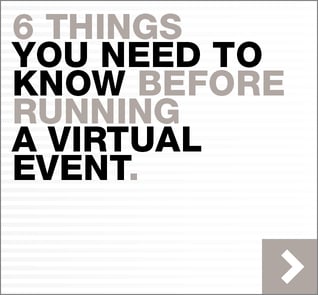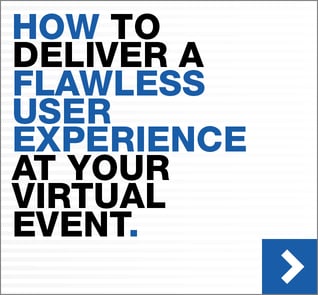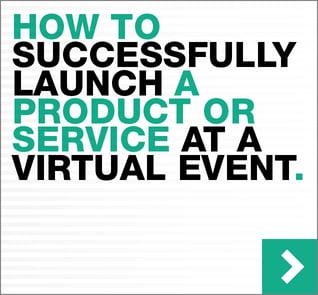
In the BBC’s reality TV show, ‘Race Across the World’, couples have to travel across several continents without flying. Episodes often begin with contestants running to the coach station, as if those 200 metres will make any difference in a month-long race spanning 10,000 miles.
In one episode, a couple splurged 5% of their entire budget on a taxi ride from London to Dover because they ‘wanted to get moving’.
Along similar lines, marketers and organisers who have had their physical events cancelled have rushed into planning virtual alternatives.
Our industry was caught off guard. The gatherings we relied upon were cancelled overnight. We all had to act fast under immense pressure, sifting through countless off-the-shelf platforms, only to find ourselves left with more questions than answers…
But this isn’t a race. The winners won’t be the first across the line. The winners will be the ones who deliver the best experience.
So what are the key risks and opportunities we need to be aware of before rushing virtual events?
The ‘unbundling’ of the events model
Exhibitors at real world events consider an event a success if they can launch a new product or create memorable brand experience.
These are the basics we need to return to. Exhibitors should ask themselves:
- What are our goals?
- Who were trying to reach?
- What are their priorities?
- How can we meet those needs digitally?
- How will we measure success?
Events organisers know that people attend events to either learn something, meet someone or sell something. Often, they want to combine all three.
Their priorities may shift depending on the sector. Science and technology usually focus on learning, finance on meeting and buying and so on.
This contextual understanding is key for creating high-value virtual experiences. But event planners should also beware the long-term threat of ‘unbundling’ their events.
The unbundling of products or services is a common trope in the startup world. Newspapers used to provide not only news but also classified ads, matchmaking services and advertising. In the last 20 years, those services have been unbundled by Ebay, Tinder, social media and online advertising platforms.
This process poses a real threat for events organisers. How is a series of seminars different from a YouTube playlist? How is virtual networking different from a Zoom call or prospecting on LinkedIn?
When you unbundle the content and the networking elements of an event, what’s left?
Real world events have been resilient to disruption because of this ‘bundling’ of marketing, networking and learning. This is no longer the case.
The smorgasbord of tech choices available can give us any solution we need for virtual events. But asking the right questions and remembering why we’re exhibiting will help us to create better and more meaningful experiences.
The distracted attendee
Compare the experience of arriving at a virtual event with a real world event. The long flight, the hotel check-in, the rushed breakfasts - all of that is gone.
In its place is a stumble downstairs, a few hours of ‘TV parenting’ and sitting in the same chair you work in everyday.
A lot of people are celebrating the time and money saved, not to mention the environmental benefits. But the ritual of arriving serves to dislocate us from the day-to-day and primes us for a new experience. It’s exciting!
The urge to leave an in-person event to answer an email is tempered by the feeling that to do so would render the cost and the travel pointless. The same cannot be said for someone who clicks on a link and arrives.
The distracted attendee is arguably the greatest hurdle for virtual events to overcome. How to overcome this is a creative challenge for organisers and exhibitors alike.
How can we make virtual events that earn the full attention of attendees?
What rituals can we create to help prime our audience and ensure they get the most from their investment?
How can we adopt the techniques of behavioural economics - so mercilessly exploited by social media platforms - to help our attendees make the most of their time with us?
The loss of exploration
Netflix co-founder Reed Hastings is quoted as saying that their main competitor is “sleep” - and that they are winning.
The main competitor for a virtual event is life. The screaming kids, the pressing deadline, the half-built shed. What is our autoplay feature going to look like?
Much of the events business model is built around the coffee break. As seminars end, dazed attendees with 15 mins to spare venture out, KeepCup in hand, to explore the exhibition hall.
Stands are designed to catch their eye and invite people in for a closer look. Live demonstrations and discussion give people another reason to engage.
What happens to all of this activity when there is no exhibition hall and no coffee break?
In the race to go virtual, many events have attempted to recreate the exhibition hall experience online. These attempts have had mixed results. Attendees have little incentive to explore and exhibitors have been left short changed.
While there are technologies available that encourage exploration, the question still remains: beyond novelty value, why would attendees explore a virtual event? Or do we need to find new ways of directing their attention?
Virtual Events Masterclass
If you’re wondering how to overcome some of the challenges raised in this guide, check out our Virtual Events Masterclass. You’ll find out how to:
- Have total confidence that your virtual event will run without a hitch
- Avoid common mistakes that first-timers make
- Create a seamless user experience for all attendees
- See what a best-in-class virtual event looks like
Subscribe and stay up to date
receive essential emails.





